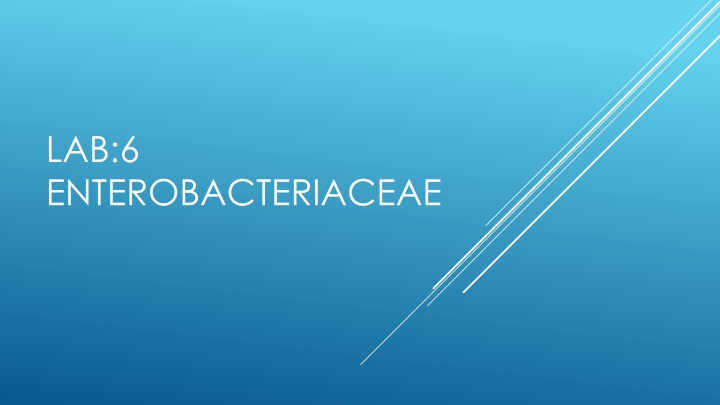
Understanding Enterobacteriaceae Bacteria Family
Explore the characteristics and identification methods of Enterobacteriaceae, a diverse family of Gram-negative bacteria that includes both harmless symbionts and harmful pathogens such as Salmonella and Escherichia coli. Learn about their appearance, key traits, and testing procedures in the lab.
Download Presentation

Please find below an Image/Link to download the presentation.
The content on the website is provided AS IS for your information and personal use only. It may not be sold, licensed, or shared on other websites without obtaining consent from the author. If you encounter any issues during the download, it is possible that the publisher has removed the file from their server.
You are allowed to download the files provided on this website for personal or commercial use, subject to the condition that they are used lawfully. All files are the property of their respective owners.
The content on the website is provided AS IS for your information and personal use only. It may not be sold, licensed, or shared on other websites without obtaining consent from the author.
E N D
Presentation Transcript
LAB:6 ENTEROBACTERIACEAE
Enterobacteriaceae is a large family of Gram- negative bacteria. It was first proposed by Rahn in 1936, and now includes over 30 genera and more than 120 species. Enterobacteriaceae includes, along with many harmless symbionts, many of the more familiar pathogens, such as Salmonella, Escherichia coli, Klebsiella, and Shigella. Other disease-causing bacteria in this family include Enterobacter and Citrobacter. Members of the Enterobacteriaceae can be referred to as enterobacteria or "enteric bacteria",
Members of the Enterobacteriaceae are bacilli (rod-shaped), and are typically 1 5 m in length. They typically appear as medium to large-sized grey colonies on blood agar, although some can express pigments. Most have many flagella used to move about, but a few genera are nonmotile. Most members of Enterobacteriaceae have peritrichous, type I fimbriae involved in the adhesion of the bacterial cells to their hosts. They are not spore-forming
Citrobacter, Enterobacter, Escherichia, Hafnia, Morganella, Providencia , Klebsiella , Proteus , Salmonella , Shigella and Serratia.
General characteristics 1- Gram negative 2- Coccobacilli 3- facultative anaerobes 4- Non spore forming 5- capsule \ + or 6- motile \ + or 7- Catalase + 8- Oxidase
Identification To identify different genera of Enterobacteriaceae, a microbiologist may run a series of tests in the lab. These include: Phenol red Tryptone broth Phenylalanine agar for detection of production of deaminase, which converts phenylalanine to phenyl pyruvic acid Methyl red or Voges-Proskauer tests depend on the digestion of glucose. The methyl red tests for acid end products. The Voges Proskauer tests for the production of acetylmethylcarbinol. Catalase test on nutrient agar tests for the production of enzyme catalase, which splits hydrogen peroxide and releases oxygen gas. Oxidase test on nutrient agar tests for the production of the enzyme oxidase, which reacts with an aromatic amine to produce a purple color. Nutrient gelatin tests to detect activity of the enzyme gelatinase.
Indole test Media culture :peptone water Reagent ;kovacs Enzymes: Tryptophanase Substrate :Tryptophan Positive result: red ring Negative result :no change
Methyl red Voges proskauer test Media culture :Glucose phosphate Reagent : Methyl red& Barrits Enzymes: Substrate : Glucose Positive result :M=red color ..V=pink color Negative result :yellow color
Citrate utilization test Media culture :Simmon citrate agar PH indicator :Bromothymol blue Enzymes: Citrase Substrate :Na-citrate Positive result : Blue color Negative result :NO growth






















